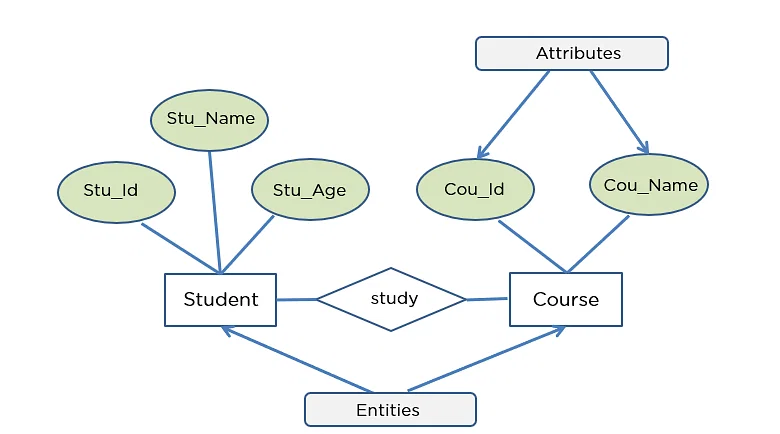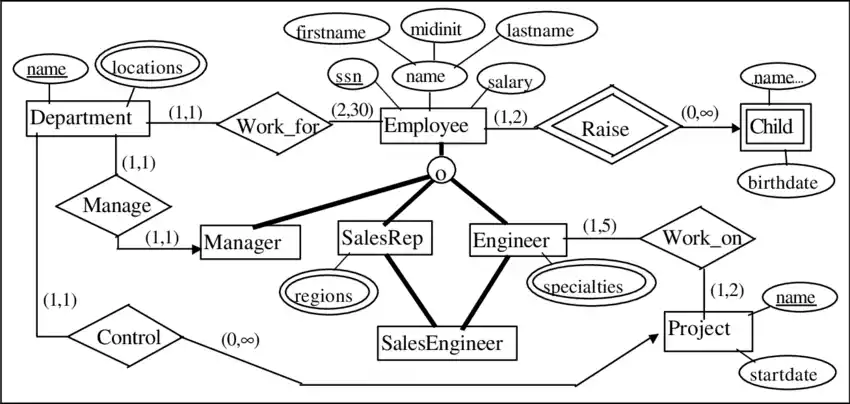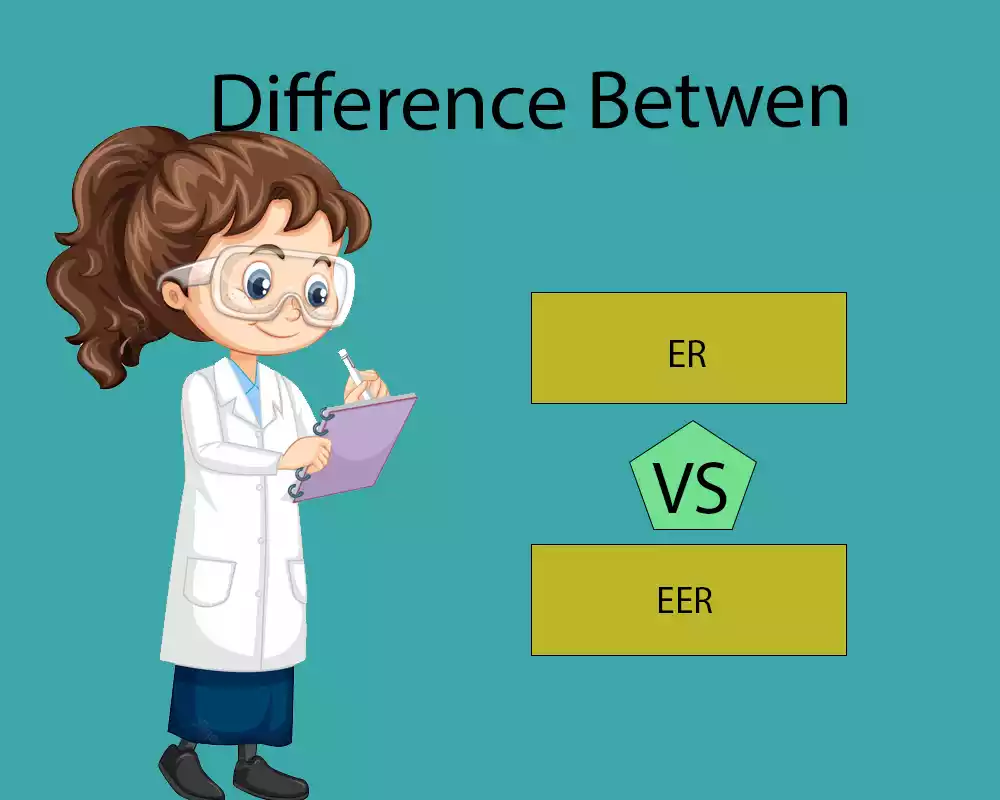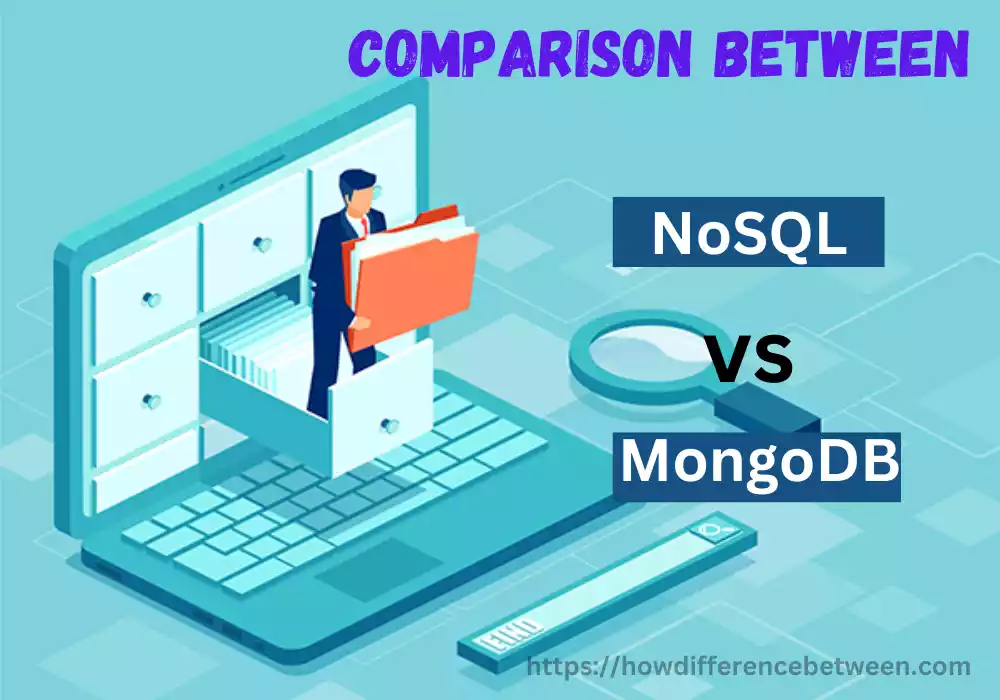Entity Relationship Diagrams (ER) and Extended Entity Relationship Diagrams (EER) are graphic displays used in database design to model relationships among entities found within it. They help designers visualize these models easily.
Brief explanation of ER and EER Diagram
ER, diagrams visually depict the attributes, entities, and relationships in a database. They serve as high-level overviews that allow designers to visually recognize entities (objects or concepts), attributes (properties or characteristics), and relationships (associations between entities). ER, diagrams use symbols like rectangles for entities, ovals for attributes, and lines with various arrowheads as representations for relationships in this way.
EER diagrams, on the other hand, extend ER diagrams by including additional concepts and symbols representing more complex constraints and relationships. EER diagrams extend modeling capabilities provided by ER diagrams by adding concepts like subclasses/superclasses/specialization/generalization hierarchies into database models to express more intricate relationships/constraints more easily.
EER diagrams can represent complex entities, relationships, and subclasses accurately in real-life situations. Since EER diagrams support inheritance – so subclasses inherit attributes and relationships of their superclasses which reduce redundancies thereby improving design efficiency – EER diagrams allow designers to accurately capture complex real-life situations with precision.
EER diagrams are an extension of ER diagrams, providing a framework for basic database modeling as well as more advanced concepts and relationships. EER diagrams also contain special features designed to more accurately represent complex database structures for improved efficiency in creating robust systems.
Importance of using diagrams in database design
Utilizing diagrams in database design offers several major benefits and plays an essential part in its completion.
Here are just a few reasons why diagrams play such an integral part:
- Visual Representation: Diagrams provide an easy visual way for designers, stakeholders, and developers to visualize the structure of a database and facilitate greater comprehension and collaboration among all parties involved in its construction. They allow these stakeholders and developers to visualize entities’ relationships to their attributes and constraints for better collaboration and comprehension of data structure relationships between entities, attributes, and constraints that enhance collaboration as well as comprehension among team members.
- Clarity and Consistency: Diagrams help ensure clarity and consistency in database designs by visually representing its entities, attributes, relationships, and any missing components early in the design phase – which promotes accuracy while helping prevent any potential issues with the final implementation of databases.
- Requirement Analysis: Diagrams provide an invaluable aid for requirement analysis by offering an easy way to visualize data requirements and quickly understand who, what, why, and when something occurs. They allow designers to better comprehend entities involved, their attributes, and relationships among them – including any missing entities, redundant attributes, or unneeded relationships which ensures the final database design meets system-wide specifications.
- Structural Design: Diagrams serve as blueprints for structurally designing databases. They help designers define entities, attributes, and relationships necessary to accurately reflect real-world domains in representations such as diagrams of entities with primary/foreign keys as well as cardinality/constraint constraints in addition to upholding data integrity/normalization principles.
- Communication and Documentation: Diagrams are an indispensable means of communication among designers, developers, and stakeholders, serving as visual references that all parties involved can easily understand – making effective dialogue possible while dispelling misconceptions and miscommunication. Diagrams serve as valuable documentation throughout a database system’s lifetime by being useful resources for maintenance, troubleshooting, and future enhancement.
- Diagrams Are an Effective Means of Optimizing Database Structure: Diagrams can assist designers in pinpointing opportunities for optimizing database structures by visualizing relationships between entities and visualizing the performance ramifications of different design decisions. Diagrams also assist designers in recognizing redundancy issues such as normalization issues or ineffective data access patterns that allow them to optimize database structures for improved scalability and better performance.
Diagrams play an invaluable role in database design as they serve as visual representations of database structures, aid requirement analysis, ensure clarity and consistency between requirements and design implementation, facilitate communication and documentation efforts and aid optimization of design.
By employing diagrams effectively designers can model and communicate database systems leading to well-designed, efficient, maintainable solutions.
ER Diagram
An Entity-Relationship (ER) diagram is a visual tool used to portray the structure and relationships among entities found within a database system. As such, it serves as an invaluable resource in database design as it enables designers to convey and comprehend database architecture effectively.

Below are key components and notations commonly seen within an ER diagram:
- Entities: Entities in databases represent objects, concepts, or things from real life which are of interest. They appear as rectangles displaying their name.
- Attributes: Attributes are properties or characteristics of entities. They serve to provide additional details about them and are represented with ovals connecting their respective entities. Attributes can either be simple (e.g. Name or Age) or compound (e.g. Address with sub-attributes such as Street Number and City/Zip Codes).
- Relationships: Relationships define associations among entities in a database structure. Representing how entities relate, relationships can provide vital insights into their inner workings. Represented visually as lines connecting related entities, they may include cardinality indicators at both ends, to indicate whether that particular relationship supports one-to-one, one-to-many, or many-to-many connections (for instance).
- Primary Key: A primary key identifies an entity within a database by providing its unique identifier; in an ER diagram this identifier underlines each instance of that entity and gives its distinct value.
- Foreign Key: A foreign key refers to another entity’s primary key and serves to form relationships among them, maintaining data integrity and consistency. They typically appear as attributes within each related entity with an underlined sign representing this unique identifier.
- Cardinality: Cardinality measures the number of instances or occurrences associated with another entity through relationships. Cardinality notations range from “1” for one instance up to multiple occurrences (“M”).
- Optional/Required: Indicators are indicators used to indicate if an instance of an entity is optional in a relationship or requires one (for instance “0..1” signifies zero to one occurrence while “1” indicates it). For instance “0..1” would signify zero or one occurrence (optional), while “1” represents required instances.
- Weak Entity: A weak entity refers to any entity which cannot be uniquely identified using only its attributes, instead relying on relationships with another entity for recognition. A double rectangle symbolizes these weak entities.
- Identification Relationship: An identification relationship connects an independent entity to its parent. It is depicted by a solid line. Relationships With Attributes: Relationships can also feature attributes that provide additional details about them – usually represented as ovals connected with the relationship line.
With its visual representations of entities, attributes, relationships, and constraints in database systems using notations and symbols, an ER diagram helps designers quickly analyze and communicate database structure effectively to achieve an efficient database system design.
EER Diagram
EER Diagrams provide an enhanced version of Entity-Relationship diagrams (ER) by including additional modeling concepts and notations to represent more complex relationships and constraints, expanding on their capabilities to give more complete representations of database structures.

Here are the components and notations commonly seen within EER diagrams:
- Entities: Entities in databases represent objects, concepts or things from real life that are of relevance to it – similar to an Entity Relationship Diagram (ER). They appear as rectangles displaying their names inside them.
- Attributes: Attributes represent properties or characteristics of entities in an ER diagram in much the same way, providing additional details about them and represented as ovals connected with them. Attributes can either be simple (Name or Age) or composite (Address with subattributes like Street Name/Address City/Zip Codes).
- Relationships: Like EER diagrams, relationships define associations among entities by depicting how entities relate to one another as well as depicted lines connecting related entities. EER diagrams also contain additional types and notations for relationships which represent how related they may be:
1. One-to-One (1:1): Represents an association where each entity instance in one entity set is linked with at most one instance from another entity set.
b. One-to-Many (1:M) Relationship: Represents an association in which each entity instance in one entity set can be associated with multiple instances in another entity set.
c. Many-to-Many (M:N) Relationship: Represents an association whereby multiple entity instances from one set can be associated with multiple instances from another entity set.
- Subclasses and Superclasses: EER diagrams enable modeling subclasses and superclasses that illustrate specialization and generalization relationships, respectively. Subclasses represent entities which inherit attributes and relationships from a superclass, with subclasses depicted using solid lines with triangle or arrowhead connectors to connect these entities with their superclass.
- Specialization and Generalization: Specialization and generalization refer to two processes used for creating subclasses and superclasses, respectively. Specialization refers to creating subclasses with unique attributes and relationships based on particular characteristics while generalization creates superclasses representing shared attributes across several subclasses.
- Inheritance Hierarchy: EER diagrams allow subclasses and superclasses to be organized into an inheritance hierarchy to illustrate inheritance relationships between classes. This structure connects subclasses directly to their immediate superclass using lines with triangles or arrowheads as depicted below.
- Constraints and Notations: EER diagrams contain additional notations and constraints designed to capture complex relationships accurately, such as disjoint and overlapping constraints to indicate whether subclasses can overlap, as well as completeness constraints which indicate whether an entity must belong to either subclass or superclass. These elements often form part of EER diagrams for accurate representations.
EER diagrams offer greater modeling capability than their ER counterpart, enabling designers to represent more intricate relationships, constraints, and inheritance hierarchies more precisely and comprehensively – providing designers with more accurate representations of database structures for designing efficient database systems.
Differences Between ER and EER Diagrams
Entity-Relationship (ER) diagrams and Extended Entity-Relationship (EER) diagrams differ primarily in their modeling capabilities and support of additional concepts, with EER diagrams offering greater complexity of presentation than their counterpart.
Here are key differences between them:
Modeling Capabilities:
- ER Diagrams: In contrast with traditional hierarchies, ER diagrams do not recognize subclasses or superclasses as entities are treated on equal terms without regard for inheritance relationships or subclasses and superclasses.
- EER Diagrams: EER diagrams allow for modeling subclasses and superclasses. Entities can be organized hierarchically with more general entities inherited by more specialized ones (subclasses).
Specialization and Generalization:
- ER Diagrams: In contrast with UML diagrams, ER diagrams do not incorporate notations for specialization and generalization of entities into categories indicating which are more specialized or general.
- EER diagrams: EER diagrams help illustrate the concept of specialization and generalization, whereby subclasses with unique attributes and relationships based on certain characteristics can be created while generalizing involves creating one superclass for shared characteristics among all subclasses.
Inheritance Hierarchy:
- ER diagrams: Mes Entities do not form hierarchies organized around inheritance relationships in an ER diagram, making inheritance relationships invisible in its structure.
- EER diagrams: EER diagrams allow for the representation of inheritance hierarchies by connecting subclasses and superclasses using lines with triangles or arrowheads to show their inheritance relationship between classes.
Additional Notations and Constraints:
- ER diagrams: Entity Relationship Diagrams (ER diagrams) feature limited notations and constraints, focusing mainly on entities, attributes, and relationships.
- EER Diagrams: EER diagrams use notations and constraints that accurately capture complex relationships and constraints, including notations for disjoint and overlapping subclasses, completeness constraints and additional relationship types such as one-to-one (1:1) or many-to-many (M:N).
EER diagrams offer an extension to ER diagrams by including advanced modeling concepts like subclasses, super classes, specialization and generalization as well as inheritance hierarchies. Overall, EER diagrams offer a more thorough and expressive way of database modeling by representing complex relationships and constraints in database systems.
Similarities Between ER and EER Diagram
ER (Entity-Relationship) diagrams and EER (Enhanced Entity-Relationship) diagrams are both graphical representations used in database design to model the structure and relationships of data elements.
While EER diagrams are an extension of ER diagrams, they share several similarities:
- Conceptual Modeling: Both ER and EER diagrams are used for conceptual modeling, which means they provide a high-level representation of the data structure and relationships without delving into implementation details.
- Entities: Both diagrams represent entities, which are objects or concepts that have attributes and can be uniquely identified within the database.
- Attributes: Both ER and EER diagrams allow the modeling of attributes associated with entities, representing the properties or characteristics of those entities.
- Relationships: Both diagrams are used to model relationships between entities, capturing how entities are related to one another.
- Cardinality: Both ER and EER diagrams support depicting cardinality constraints in relationships, indicating the minimum and maximum number of occurrences of entities that can be related.
- Keys: Both diagrams allow for the specification of primary keys, which uniquely identify individual instances of entities.
- Diagrammatic Notation: ER and EER diagrams share common graphical notations for representing entities, attributes, relationships, and cardinality, making them easy to understand for database designers and stakeholders.
- Abstraction: Both diagrams provide an abstraction layer that allows designers to focus on the logical structure of the data without getting into the technical implementation details.
- Visual Communication: Both diagrams serve as visual communication tools that enable effective communication and collaboration among stakeholders, including developers, designers, and business analysts.
- Complexity: While EER diagrams can represent more complex scenarios due to their enhanced features (like subtypes and inheritance), both ER and EER diagrams are useful for a wide range of database design tasks.
It’s important to note that EER diagrams extend the capabilities of ER diagrams by introducing additional features like subclasses, inheritance, and specialization/generalization, allowing for more advanced and refined modeling of data relationships and constraints.
Conclusion
ER and EER diagrams are invaluable tools for effective database design. They provide a visual roadmap for organizing data, defining relationships, and ensuring data integrity. By following best practices and avoiding common pitfalls, developers can create well-structured databases that support efficient and accurate data management.































